The most interesting poisons

Hi% username%!
Again evening, again I have nothing to do, and I decided to spend some time to write the third part of my cycle about poisons. I hope you read the first and second parts, and you liked it.
In the third part, we have a little rest. There will not be a story about those poisons that you meet at every step - most likely even the opposite. There will be no holivar about the dangers of alcohol and nicotine.
')
In the third part I will collect those poisons that for some reason seemed interesting to me (if such a word applies to poisons in general - but, as I said: I am an artist, I see it).
So again, my death dozen! Go.
Tenth place
Homidium Bromide

Humanity has always been curious. And in its curiosity, it sometimes inadvertently creates monsters.
Homidium bromide was created as an intercalating agent for molecular biology in order to identify and study nucleic acids, in particular, in the case of electrophoresis of DNA or RNA in an agarose gel.
The word "intercalating" is key here. By definition, intercalation is the reversible inclusion of a molecule or group between other molecules or groups. Homidium bromide interacts with nucleic acids, including between bases.
Who cares - it looks like this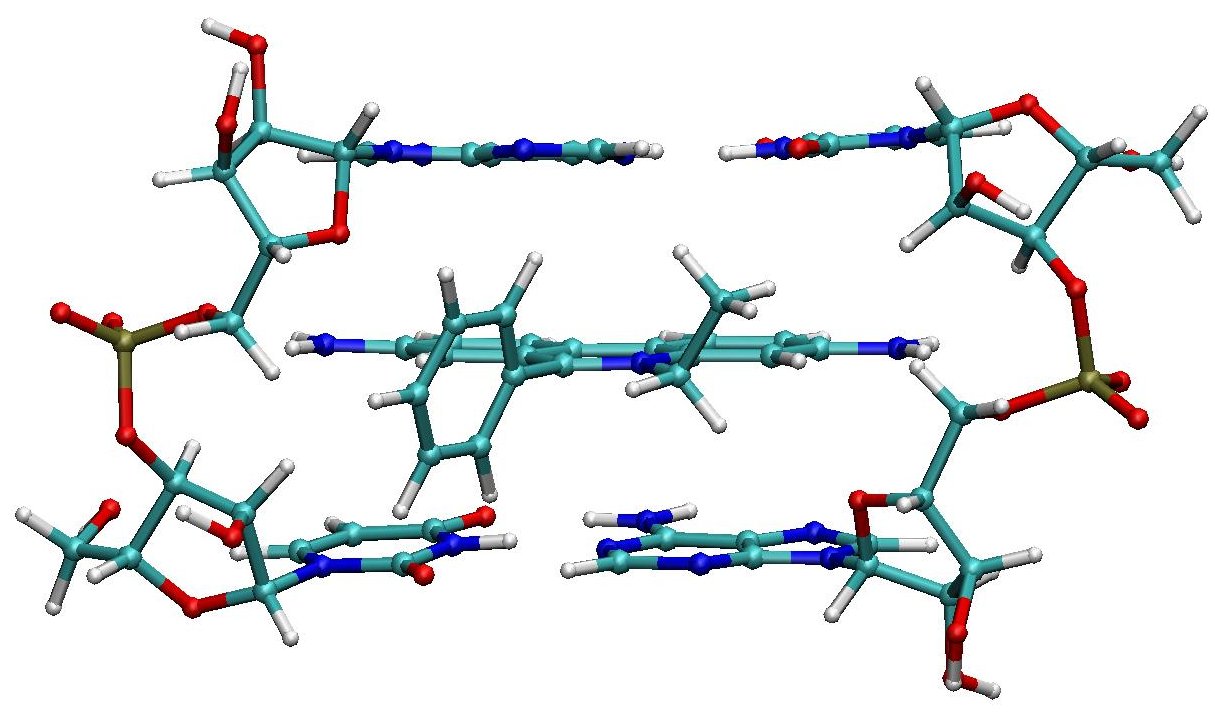

In practice, homidium bromide, even in small doses, inhibits DNA synthesis and RNA and reverses the supercoiling of the circular DNA. This substance is almost the most powerful of the known mutagens.
There is no information in the literature about how much homidium bromide should be taken in order to die guaranteed. There is no information on how this death will take place. Scientists are still arguing whether this substance is carcinogenic.
% username%, homeidium bromide - a great way to learn something new about your body in the spirit of STALKER Dare!
Ninth place
NNG

If you are not satisfied with the tenth place - meet: N-methyl-N'-nitro-N-nitrosoguanidine! Well, or simply and modestly:
Remember, I was talking about "almost the most powerful mutagen"? So, NNG is the most powerful. Unlike the sickly homidium bromide, NNG always causes more than one mutation per cell. The masters of genetic engineering, when they conducted their experiments with E. coli, used NNG.
And by the way, NNG is 100% carcinogenic. Tumors in this case, there are multiple, always - recurrent.
Among other things, NNG:
- Unstable. By itself, this substance is a powder, but it constantly decomposes, and when stored in a closed vessel, it explodes.
- Reacts violently with water.
- May explode when hit.
- Sensitive to heat, light, moisture - explodes without warning.
- Flammable.
- Incompatible with aqueous solutions, acids, alkalis, oxidizing agents, reducing agents - a violent reaction with an explosion.
- Alkaline hydrolysis during deactivation produces toxic and explosive gases.
Although in terms of toxicity, NNG is pretty sweet: rats die at doses of about 90 mg / kg. Given the basic properties of NNG, we can say that they were lucky.
Eighth place
Heptyl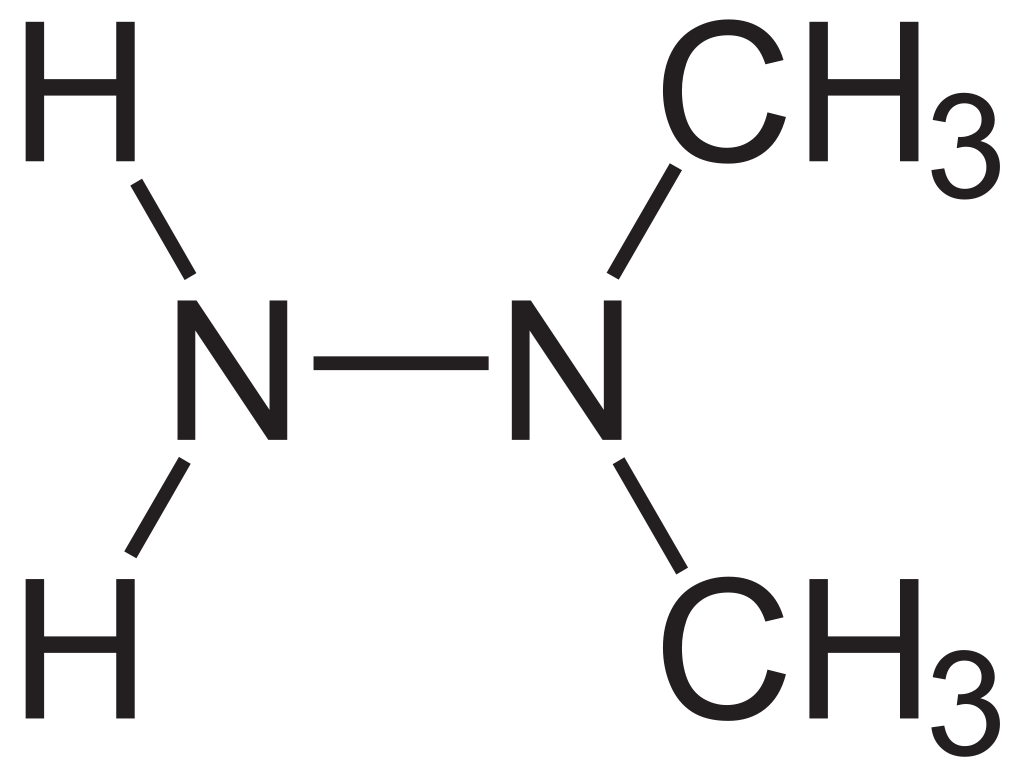

For centuries, man has dreamed of flying. In the last century, the dream came true in space. Every year, mankind cherished thoughts about the exploration of the Moon, Mars, flights to other stars.
Then the race dried up. The competition disappeared, the enthusiasm was lost, everyone began to count money and suddenly discovered that it was much more interesting to earn money on smartphones and processors than to fly somewhere.
But I'm not talking about that. Heptyl or asymmetric dimethylhydrazine (UDMH, 1,1-dimethylhydrazine) is a component of high-boiling (having a boiling point above 0 ° C) rocket fuel. As an oxidant, paired with heptyl, diazoto tetraoxide (AT), pure or mixed with nitric acid, is often used; there are known cases of using pure acid and liquid oxygen. To improve the properties of heptyl was used in a mixture with hydrazine, known as aerosin.
This fuel (and this is exactly rocket fuel!) Was used and is used, in particular, in the Soviet launch vehicles “Proton”, “Cosmos”, “Cyclone”; American - family "Titan"; French - family "Ariane"; in propulsion systems of manned spacecraft, satellites, orbital and interplanetary stations.
Heptyl is a colorless or slightly yellowish transparent liquid with a sharp unpleasant odor characteristic of amines (the smell of spoiled fish is similar to the smell of ammonia, very similar to the smell of sprats). It mixes well with water, ethanol, most petroleum products and many organic solvents. Self-igniting when in contact with oxidants based on nitric acid and tetraoxide diazota, which simplifies the design and provides an easy start and the possibility of multiple activation of rocket engines. This is one of the advantages, they also add greater efficiency per unit mass of the fuel mixture (surpasses a pair of oxygen + kerosene and a pair of oxygen + hydrogen in density - 1170 kg / m³ against 1070 kg / m³ and 285 kg / m³, respectively) and the possibility of long-term storing missiles in the filled form at normal temperatures.
Now - about the unpleasant.
- Heptyl is four times more toxic than hydrocyanic acid. Effect on the human body: irritation of the mucous membranes of the eyes, respiratory tract and lungs, strong excitation of the central nervous system, upset gastrointestinal tract (nausea, vomiting), loss of consciousness, death.
- Flash point −15 ° C; self-ignition temperature 249 ° C; concentration limits of flame spread 2–95% vol. This means that heptyl very readily lights up and burns very happily (who would doubt).
- Heptyl fumes are extremely explosive, losing, except that hydrogen is oxygen.
- Mutagen. Carcinogen. And so strong that it is used to reliably induce colorectal carcinoma in rats in studies of tumors.
How do you like that, Ilon Musk? In short,% username%, I do not envy you if you live near the cosmodrome.
Seventh place
Cantharidin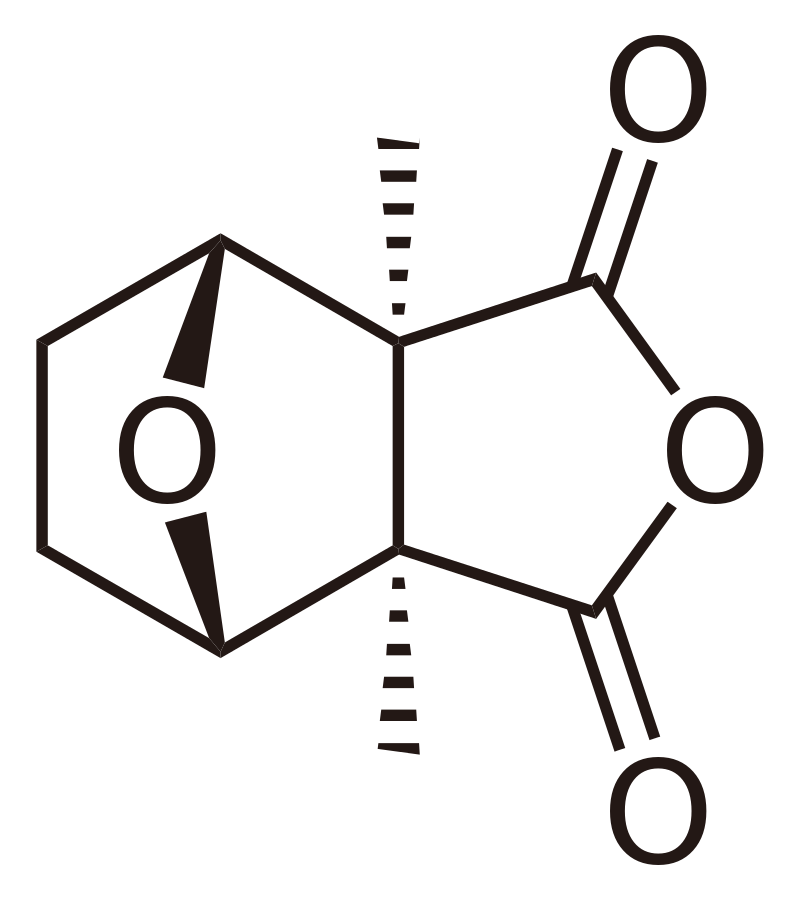

In addition to flying, humanity has always had more interesting things to do. For example, at all times, men are very complex about their capabilities - and yes, yes! I am now talking about exactly those opportunities!
It is now in search of drugs for stenocardia to some peasant surely got lucky - and sildenafil appeared - well, or viagra via the common people. And before that it was much more complicated!
One of the popular options was to take this kind of living creature:

No,% username%, this is not a green cockroach at all, but a Spanish fly. And its history is quite old and very colorful:
- In the days of Rome, Livia, the wicked wife of Octavian Augustus, spiked food with the hope that she would inspire the guests of Libya to indiscretion, which would help her in the future to blackmail them.
- In 1572, Ambroise Pare wrote a report about a man suffering from "the most terrible satiriasis" (we call it a different word now, but started it himself) after taking a potion, which included nettle and Spanish fly.
- In the 1670s, the fortune-teller and healer, La-Voisin, offered a "love potion" from Spanish fly, mole mole dried blood and a bat.
- In the "Marseilles case" Marquis de Sade was charged with the use of "spanning flies."
And all the fault of cantharidin, which is already up to 5% in secret of this cockroach! By the way, not only: cantharidin is contained in the hemolymph of beetle beetles, T-shirts and some barbel beetles. And yes, in small doses, it is exactly what an elderly Chevalier needs, surrounded by young courtesans!
The problem is that besides the same action, cantharidin also has skin-blistering properties. But since it was not rubbed, but drank, then: after getting into the digestive tract in doses of about 0.5 mg / kg, rapidly developing intoxication began - abdominal pain, vomiting, urine with blood, acute inflammation of the kidneys, development of renal failure. An overdose at the level of 40-80 mg / kg reliably and permanently resolved the question of communicating not only with women, but also with all living things: during the subsequent autopsy there was a sharp hyperemia of mucous integuments, the formation of ulcers and foci of hemorrhage, diffuse lesions are found in the liver and kidneys .
Is it worth the risk? History said yes.
And because the success of Viagra is not surprising.
Sixth place
Paraquat

Since we are talking about humanity and people, you know,% username%, when I was preparing a list of members of this hit parade, for some reason I began to understand algae, mushrooms, and all that maliciously poisonous flora and fauna that surrounds us . Because it is more evil and that is characteristic! - randomly poisonous animal, like a man - I could not find. Moreover, “randomly” is a key word, because a person poisons both the flora, and fauna, and himself as well.
Paraquat is an organic compound, the trade name for N, N'-dimethyl-4,4'-dipyridyl dichloride. In the form of a quaternary ammonium salt, paraquat is widely used as a strong non-specific herbicide. By the way,% username%, and you have your own website? But paraquat is !
Paraquat is used to remove broadleaf weeds and grass, but it is less effective in dealing with deep-seated weeds. This herbicide does not affect the bark of trees, so it is widely used to control weeds in orchards. In the 1960s, paraquat was also used by the United States to fight marijuana and coca plantations in South America (for some reason, I remembered the story of Yellow Rain and Orange Agent - remind me later if you want to listen to this story too).
Paraquat is highly toxic to animals and humans. The lethal dose may be about one teaspoonful of the substance. When ingested paraquat with the bloodstream enters all tissues of the body, and more selectively accumulates in the lungs. This causes swelling and other lung damage that can lead to fibrosis. In addition to the lungs, the liver and kidneys can also be damaged (renal failure).
At the moment, paraquat is used as a herbicide in 120 countries (in Russia it is not used - here I was even surprised!).
What can I say? Enjoy your meal.
Fifth place
Endrin

Endrin was synthesized in 1949 by Kurt Alder. Commercial production of endrin began in the USA in 1951, where it was used as a pesticide along with aldrin. It was found that this substance is more than 2 times more effective than aldrin and 10-12 times DDT. He proved to be effective in combating:
- caterpillars and aphids on tobacco, maize, sugar beets, sugar cane, cotton and other crops;
- blackcurrant kidney mite, against which all other drugs are ineffective;
- mice and other rodents;
- people (what ???) .
Yes, yes, my dear friend, human toxicity to endrin aerosol is comparable to that of hydrocyanic acid. It affects mainly the nervous system. Absorbed through the skin. It has a long half-life from the body. Charm, right?
In acute endrin poisoning, motor arousal, rapid breathing, muscle twitching, flinching, and tonic convulsions are characteristic. Death occurs after several attacks of convulsions due to paralysis of the respiratory center. Cases of acute poisoning as a result of the consumption of bread baked from contaminated flour with an endrin content of 150-5500 mg / kg are described. The first signs of intoxication were usually observed after 2–3 hours (general malaise, nausea, vomiting, weakness, heavy sweating). In more severe cases, convulsions, temporary deafness, paralysis, movement disorder, and paresthesia are described. Recovery occurred quickly, but sometimes, as a result of the poisoning, short-term disorientation, aggressiveness, and intellectual disability were noted.
In 1969 (18 years later !!!), endrin was excluded from the list of substances protecting plants because of its tendency to bioaccumulation (by the way, did I say that it is insoluble in water?). However, this pesticide was used in some countries until the early 1990s. By decision of the Stockholm Convention of May 23, 2001, there is a global ban on the production, sale and use of endrin, as one of the extremely toxic and resistant to the influence of the external environment pesticides.
The total amount of endrin produced since 1951 has been ~ 5,000 tons, of which more than 2,500 tons are in the United States. No one knows what is with him there now and whether they have not poured him somewhere quietly - and this is sad.
Fourth place
Ricin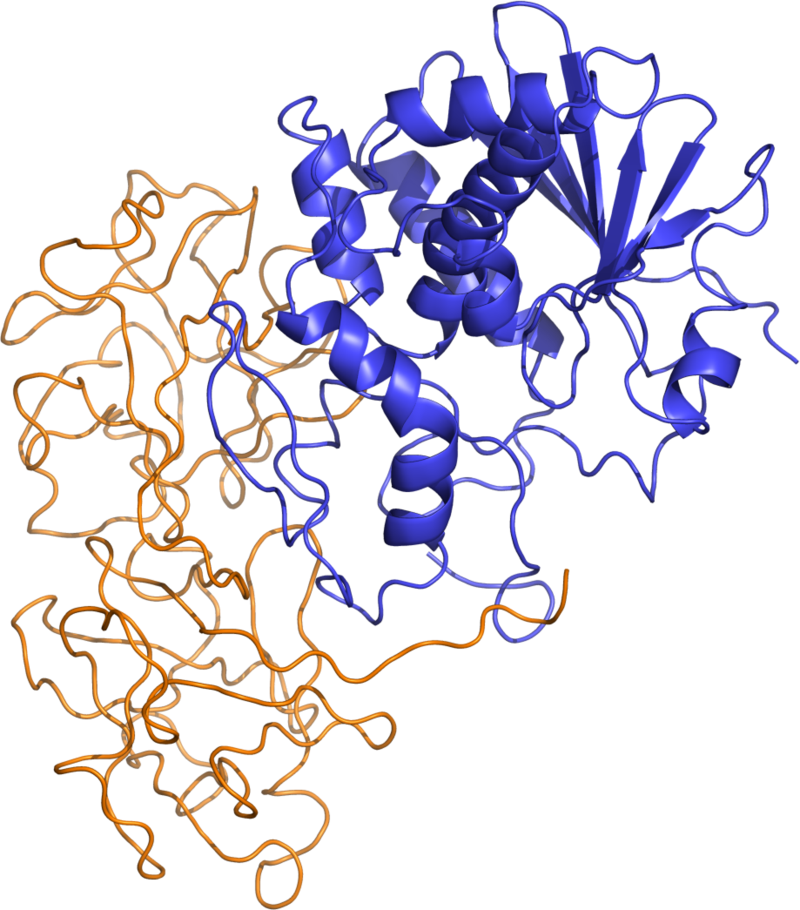

Do you know what a username is,%% username? This is sunflower cake, what remains when oil is obtained from the seeds. My grandfather brought home such healthy disks of a makuha - he then caught fish for it.
Have you ever seen castor oil,%% username? I don’t ask if I drank, although by the way - the best and most environmentally friendly means to solve some delicate problems.
Have you seen castor cake,%% username? Not? Believe: and you will not see.
Castor oil castor oil is made from castor bean seeds - in warm countries it is such a bush up to 10 m high, because of the
It looks like this grass

And so - 'castor nuts'

So,% username%, you will never see the castor cake, because this is a strategic poison and is subject to strict accounting and disposal. Glycoprotein ricin, which is contained in castor bean seeds, is probably the strongest plant poison in the world, unless we consider plants to be algae (there is still a competitor abrin — it is lower about it, but everything is not so simple with it). Ricin is 6,000 times more toxic than cyanide. The mechanism of the toxic action of ricin is also beautiful: inhibition of protein synthesis by ribosomes. That is, these very small intracellular things, which synthesize everything and make cells useful, suddenly stop working. Everywhere. Such is the intracellular strike.
In fact, the strike manifests itself in the following way: nausea, vomiting, pain and burning sensation in the esophagus and stomach, diarrhea, headache, drowsiness, anuria, leukocytosis, red blood cell agglutination (this is when they stick together and precipitate directly in the vessels and the heart) - well, then collapse and death. It's simple.
Since a small dose of ricin the size of a pinhead is enough to kill an adult, it is clear that it became very interesting to people and the methods of using ricin as a weapon of mass destruction were studied by the military departments of different countries since the First World War. However, due to a number of shortcomings, this substance was never put into service.
However, ricin was used by the special services. One of the most famous incidents involving ricin was the murder of the Bulgarian dissident Georgy Markov, who was poisoned in 1978 with an injection by an umbrella with a special design. According to other sources, the killer’s weapon was a pneumatic gun that fired a microcapsule with ricin and disguised as an umbrella. The dose administered to Markov was no more than 450 micrograms (or 0.45 milligrams).
The simplicity of getting the toxin made it potentially accessible to terrorist groups. Thus, in 2001, the press reported on the discovery of instructions for making ricin at the defeated Al-Qaida base in Kabul. In 2003, a number of ricin was found among terrorists in London, traces of ricin were found in a storage cell at the Lyon station in Paris.
In 2013, a number of Mississippi officials were arrested for attempting to send ricin letters to US President Barack Obama and other US high-ranking officials. So, in May of the same year, a letter with threats containing ricin was sent to the mayor of the city of New York, allegedly in response to the activities of the public organization “Mayors Against Illegal Weapons”.
Later in Texas, the actress Shannon Richardson, who was suspected of sending letters of deadly poison to American politicians, was charged. Strangely enough, the Russian trace was not noticed here, and therefore it became boring for everyone and the history was forgotten.
By the way, another cute representative of the flora has the same effect - prayer bead or
Abbrus precatorius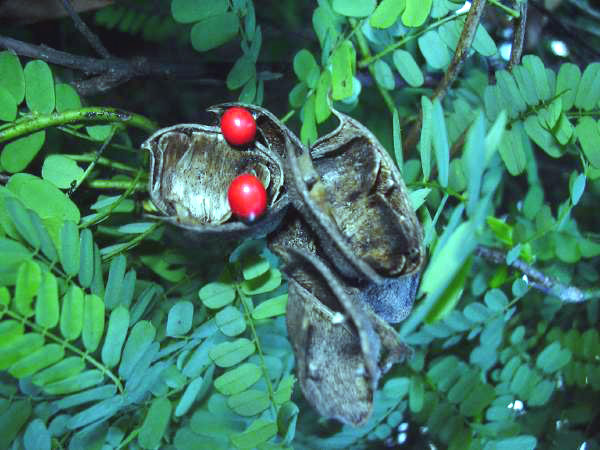

This plant grows wild in India and is cultivated in the tropics of both hemispheres. The chechetnik got its name for making rosaries from its seeds. Prayer abrus root is sometimes also called Indian licorice and is used instead of licorice root - it is not poisonous at all.
The seeds of the chetnika (those very rosary!) Contains the protein toxin abrin. With the same mechanism, abrin is about 30 times more toxic than ricin, and therefore,
Symptoms of Abrin poisoning depend on the type of admission. Within hours of inhalation, general symptoms include fever, cough, irritation of the respiratory tract, chest tightness, pulmonary edema, and nausea. Breathing is difficult, the skin acquires cyanosis (cyanosis). As the poisoning develops, a person can sweat a lot, but fluid in the lungs will still accumulate further. In the end, respiratory failure occurs, which is fatal within 36-72 hours.
Swallowing any amount of abrin can cause severe symptoms. Early symptoms include nausea, vomiting, pain in the mouth, throat and esophagus, diarrhea, dysphagia (problems with swallowing), abdominal cramps and pain. As symptoms develop in the gastrointestinal tract, bleeding and inflammation begin. Vomiting begins, black, tarry diarrhea. Loss of blood and water due to nausea, vomiting, diarrhea and bleeding leads to a drop in blood pressure and the onset of organ damage, resulting in severe sleepiness and the appearance of blood in the urine. Then comes stupor, convulsions, polydipsia (thirst) and oliguria (low urine output). Ultimately, this leads to systemic organ failure, vascular collapse and death.
Abrin can be absorbed through damaged skin or absorbed through the skin when dissolved in certain solvents. Abrin in the form of a powder or fog can cause redness and pain in the eyes in small doses, higher doses can cause tissue damage, severe retinal hemorrhage, as well as visual impairment or blindness.
At the moment, abrin is not as well described and distributed as ricin. Perhaps because of the interest of these services.
And yes, there is no antidote for both substances.
Third place
Since we started talking about grass, then remember about the algae. And now I’m not talking about those who cling to the legs when swimming - although it is so disgusting that it is worse than any poison (as for me). No, I'm talking about such tiny microscopic rubbish, which they say: “the sea has bloomed!”. Those that still glow at night, for example, like this:

Okay, okay, I confess - I joked, although a little later it will be clear that Cherenkov radiation is no worse.
Shine algae so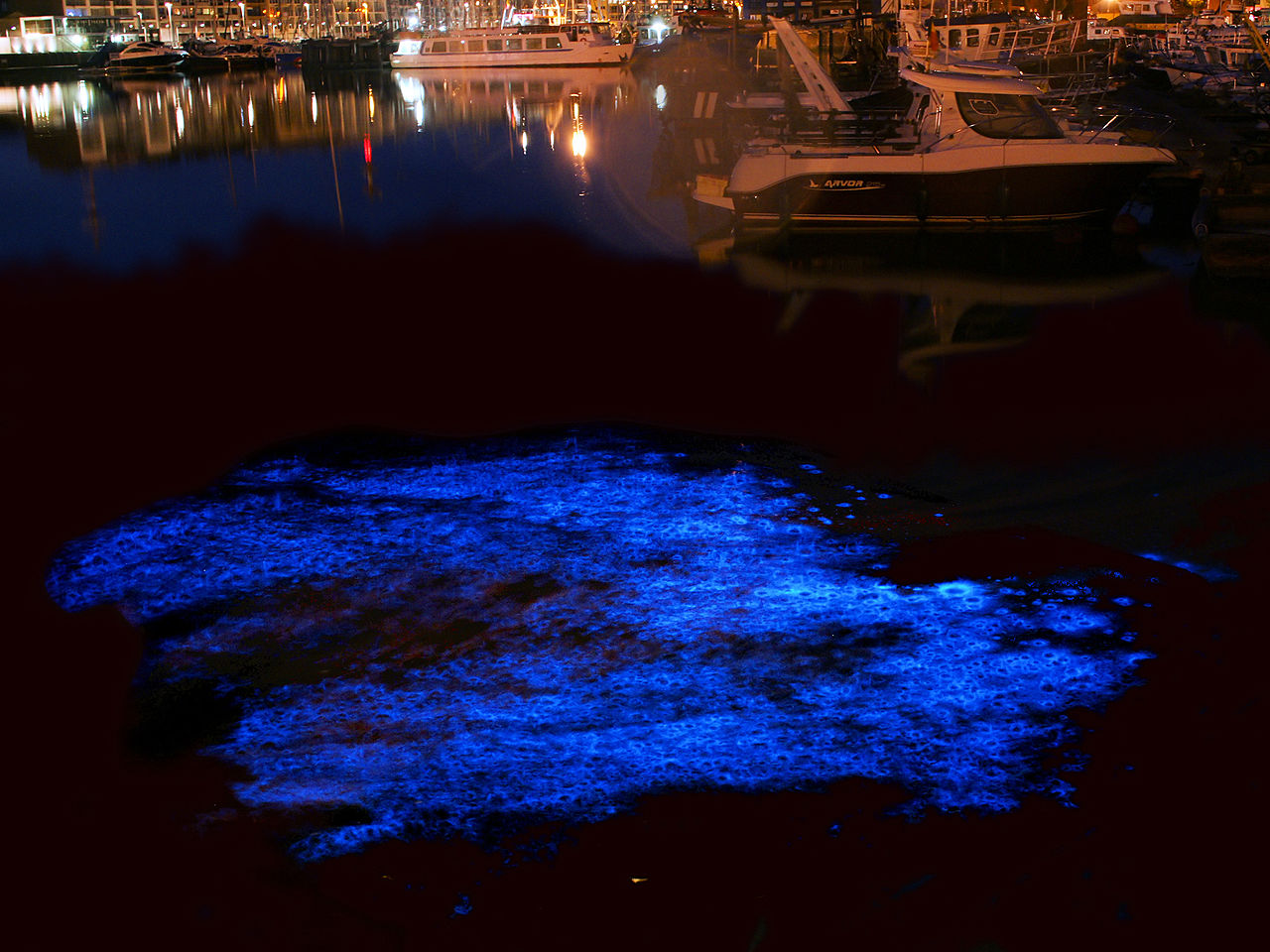

This stuff is small, but it is a lot. She - almost the bottom of the food chain of the water world. Who ever notices her?
And in vain.
Algae, called dinoflagellates and blue-green algae, deserve special attention. And more specifically:
- Dinoflagellates Gambierdiscus toxicus
- Blue-green algae Gonyaulax catenella, Alexandrium sp., Gymnodinium sp., Pyrodinium sp.
- Dinoflagellates Anabaena sp., Aphanizomenon spp., Cylindrospermopsis sp., Lyngbya sp., Planktothrix sp.
All these friends produce a whole list of toxins recognized as one of the most toxic substances on this small planet. I will name and describe the sweetest ones.
Matotoxin

Produced by citizen number 1 in the list above. It is the most toxic of the group of brevetoxins: approximately 0.2 μg / kg is enough for your relatives to receive insurance for sure. The mechanism of action is due to the modification of potential-dependent Ca-channels, an increase in the concentration of Ca2 + inside the nerve cells, spontaneous release of acetylcholine into the blood and sustained postsynaptic depolarization. In short, powerful and irreversible paralysis.
The molecule itself is a mitotoxin system of 32 condensed carbon rings. It is one of the largest and most complex non-protein molecule produced by a living organism. I hope this will console you if it gets you inside.
Oh yeah, I almost forgot, piquant detail: being a representative of brevetoxins, matotoxin, before causing flaccid paralysis of muscles and respiratory arrest, will surely make you salivate, have a bad cold and spontaneous defecation. In short, to accept death with dignity will not work.
Saxitoxin

Produced by a group of citizens number 2 and 3 in the list above. Not as cool and beautiful as matotoxin, but no less misanthropic: eating 2 mcg / kg will make all of humanity miss you. The mechanism of action of saxitoxin is the blockade of potential-dependent sodium channels of nerve fibers. This blocks the conduction of nerve impulses and causes muscle paralysis.
Saxitoxin is interesting, that its name is associated with the name of quite edible mollusks of the genus Saxidomus, which are also called “Washington clams” and “oily clams” (“Washington clams” and “butter clam” if not in our way). Well, the name makes it clear where they like to eat. So, these cute creatures will dare to eat algae, and when there are many of them during the periods of their rapid reproduction (“red tides”) they are willing to accumulate all the toxins in themselves. I don’t know why: you can think about evolution, about increasing resistance - but the poison of algae works very well on warm-blooded - and not very cold-blooded. Especially on clams.
In short: having eaten seafood in the period of red tides, you can make a last meal.
It is clear that the most democratic country in the world could not pass by such a find, and therefore saxitoxin is considered as an object for use as chemical weapons and in the US military is marked as TZ.
Microcystin-LR

Chemically, microcystin-LR is a cyclic heptapeptide. That is, these are seven amino acids that took hold of the handle and wove such a nice round dance. By the way, one of them is a unique β-amino acid, usually all amino acids in alpha are peptides. Really nyashno? Not? Well, okay!
Microcystin-LR is in fact simply the most vicious of all microcestins produced by blue-green algae - citizens number 2 in the list above in particular, but in general - by all blue-green algae. And they have enough of them, believe me! Microcystin inhibits the activity of type 1 and type 2A protein phosphatases (PP1 and PP2A) in the cytoplasm of liver cells. This leads to an increase in protein phosphorylation in the liver cells, which reliably bends this vital organ. But - not least! - bends in perspective.
No one has ever noted the short-term toxicity of microcystins. However, it is believed that the vast majority of liver problems - including liver cancer - are somehow related to chronic blue-green algae poisoning. WHO, in particular, is very worried .
It is for this reason that the top three winners in our charts have discovered the toxins of small - but very proud algae, which have long been tired of all of humanity.
Second place
VX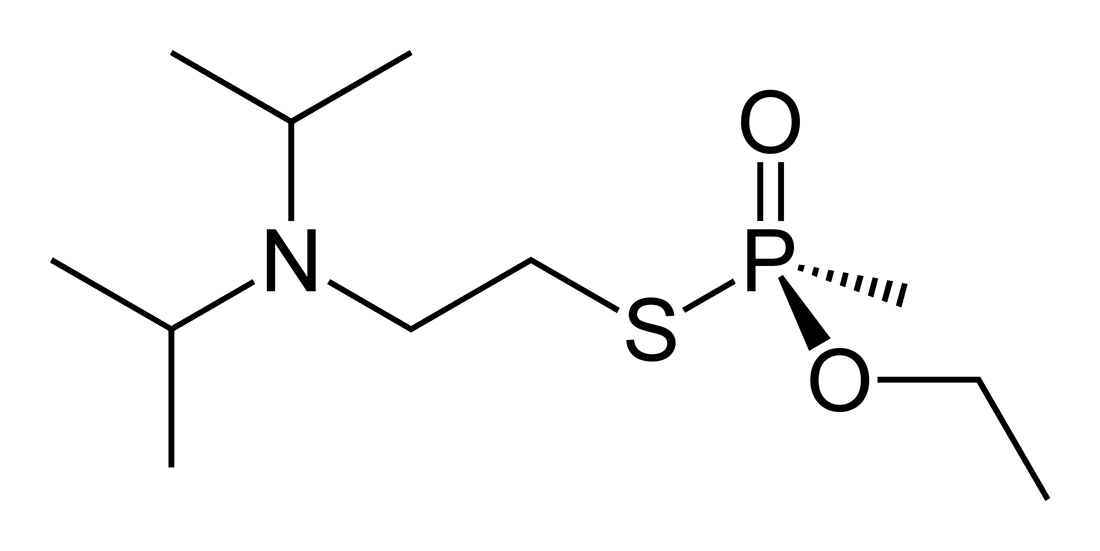

The village once humankind on the bench and thought: around so many different things, interesting, which can poison us in so many ways. And why are we worse?
And invented.
Since the early 1950s, a number of phosphoric acid O, S esters containing a dialkylaminoethylthio group have been studied in the UK.The goal was quite a sweetheart: new insecticides were developed. But suddenly it turned out that the resulting compounds, called phosphorylthiocholines, are extremely toxic to warm-blooded animals. It is clear that the topic of insecticides immediately became uninteresting to everyone - and real experts took up the case.
Specialists practiced a bit
VX is the most toxic substance ever produced artificially for use in chemical weapons. Like all such organophosphorus agents, VX is an acetylcholinesterase inhibitor: it selectively inhibits this enzyme, which catalyzes the hydrolysis of acetylcholine, a mediator of nervous excitement. Acetylcholine hydrolysis in a healthy body occurs continuously and is necessary to stop the transmission of nerve impulses, which allows the muscle to return to a state of rest. The phosphorylated cholinesterase formed in the course of VX poisoning, unlike acetylated, is a strong compound and does not undergo spontaneous hydrolysis. Thus, the destruction of acetylcholine molecules is inhibited and it continues to exert a continuous effect on the cholinergic receptors. This leads to a generalized overexcitation of cholinergic receptors,causing at first strong arousal, and then paralysis of the function of organs and tissues. In this regard, the main symptoms of VX poisoning can be interpreted as a manifestation of excessive, impractical for the body activity of a number of structures and organs, which is provided by acetylcholine mediation. First of all, these are nerve cells, striated and smooth muscles, as well as various glands.
Symptoms of defeat: 1-2 minutes - constriction of the pupils; 2-4 minutes - sweating, salivation; 5-10 minutes - convulsions, paralysis, spasms; 10-15 minutes - death.
For a person, LD 50 percutaneously = 100 µg / kg, orally = 70 µg / kg. LCt 100 = 0.01 mg · min. / L, while the period of the hidden action is 5-10 minutes. Mioz occurs at a concentration of 0.0001 mg / l after 1 minute.
Yes, that's right - the attentive reader correctly noted the word “sclera”: VX has a very high skin-resorptive toxicity compared to other phosphorus-containing toxic substances. The most sensitive to the action of VX is the skin of the face and neck. Symptoms in case of skin admission develop after 1–24 hours, however, if VX gets on the lips or damaged skin, the action manifests itself very quickly. The first sign of resorption through the skin may not be miosis, but minor muscle twitching at the point of contact with VX, then convulsions, muscle weakness and paralysis.
The toxic effect of VX through the skin can be exacerbated by substances that are not toxic in themselves, but are able to transport the poison into the body. The most effective among them is dimethyl sulfoxide and N, N-dimethylamide palmitic acid. What do you think,% username%, have there been any works and are there any mixtures in which this remarkable property would be used? Prralna!
It infects VX open water bodies for a very long period - up to 6 months. Well, and buildings and everything else around, infected with VX drops, are dangerous in the summer for 1-3 days, in the winter - 30-60 days. In general, VX resistance on the ground (skin resorptive effect): in summer - from 7 to 15 days, in winter - for the entire period before the onset of heat.
And you're talking about a nuclear winter ... The
world knows several cases of using VX.
- 1994 1995 , « » 100 200 VX, . , . , 28- , , VX, - . , , 7:00 12 1994 . VX . 100 , ; 10 , . , - , , . VX, , -2-(). , VX ( ).
- On February 13, 2017, with the help of VX, Kim Jong Nam was killed - half-brother of Kim Jong-un, ruler of the DPRK. The murder occurred in the departure area of the international airport in Kuala Lumpur (Malaysia). The murder involved two women. One distracted Kim Jong Nam’s attention, while the other at the back threw a handkerchief soaked with toxic substance on his face. Nam felt bad, he was taken to the hospital, but on the way he died.
Well, as usual, when humanity a bit came to its senses and realized what created it — the reverse reaction went. The 1993 Chemical Weapons Convention prohibits V-gases, which means that they cannot be produced and existing stocks must be destroyed. But there are nuances.
- Only Russia and the United States admit that they have or had reserves of V-gases, however, presumably, other countries also have some of this poison.
- On September 27, 2017, Russian media reported on the complete destruction of chemical weapons stocks in Russia, including VX. No one believed it.
- Cindy Westergaard, an expert on chemical weapons and a senior researcher at the Stimson Center, says that Iraq “produced the VX exactly” in the 1980s, but there is no evidence of its use. Everyone believed it. By the way, at present, VX is still available in the US arsenals (military marking - three green rings with the inscription VX-GAS). But all do not care.
- The DPRK, along with Egypt and South Sudan, has never signed or ratified the Chemical Weapons Convention.
And at once - a few words about the "Novice".
Newbie Connection Group

It is customary to associate with “Novice”:
- A-230: N- (methylfluorophosphonyl) -N ', N'-diethyl-acetamidine (in the figure to the left), freezes in cold weather;
- -232: N-(O-)-N',N'-- ( ), ;
- -234: N-(O-)-N',N'--, , , .
These compounds were presented by Viktor Kholstov - a member of the Russian delegation at the 57th and 59th Sessions of the Executive Committee of the Organization for the Prohibition of Chemical Weapons, however, the family itself consists of more than sixty similar compounds.
There is an opinion that the “Novice” is more toxic than VX, however, no figures on toxic doses are given. In words, “Novice” is 5-10 times more toxic.
In fact, this story is so much muddy that it deserves a separate article. But since it will be based only on my understanding of the sources, and not on objective facts (well, I don’t have access there — not-that!) —Thinking a little, I decided that everyone should draw a conclusion from this story. It’s enough to read books and interviews:
Home reading
- Hoenig, Steven L. Compendium of Chemical Warfare Agents. - Springer, 2007.
- Fedorov, Lev A. From chlorine and phosgene to Novice. The history of the Soviet chemical weapons. - Moscow: Motherland, 2019.
- Mirzayanov VS State secrets: an insider's chronicle of the Russian chemical weapons program. - Denver, Colorado: Outskirts Press, 2008.
- A lot of links to Wikipedia
Frankly, I understand that people who have gone there, as well as those who remain here will not always tell what is actually in the game when the stakes are so high. So read the% username%, think, analyze - and draw your own conclusion!
In the meantime ...
We have a winner! First place
The inquisitive mind of a rational man still did not let up after the opening of the VX. After all, in fact, it was found a substance that could potentially infect everything around worse than an atomic explosion - and what if it all cross together?
Well then, a few words about radiation.
Humanity knows several types of radiation. Speaking simple and accessible language, it happens:
- Radiation caused by photons - UV, X-ray, gamma
- Electron Radiation Beta
- Elementary particle radiation - neutrons, protons
- Radiation caused by larger particles - alpha
If it is in your head, dear% username%, to run with a pea, a tennis ball, a basketball and a pood weights - why are you more upset? So with the radiation the same thing - the harder, the harder. Well, it is clear that everything depends on the speed.
In fact, the harm from alpha particles is maximal - and that is why for alpha particles the quality factor is 20 and this means that with an equal amount of radiation energy absorbed per unit mass of an organ or tissue, the biological effect of alpha particles will be twenty times more strong than the effect of gamma radiation.
Fortunately, the alpha particles are so heavy and so strongly collide and interact with everything that they practically do not penetrate the dead skin particles. But…
Polonium-210

There is no pure polonium-210 in the world, although it is contained in trace amounts in all uranium and thorium ores. In its pure form, it is obtained artificially. More precisely - received. Experience has shown that the properties of polonium-210 for humanity are practically uninteresting, except for one thing:
- Polonium-210 in alloys with beryllium and boron was used for the manufacture of compact and very powerful neutron sources, practically not creating γ-radiation. However, now this niche is tightly occupied by California.
- -210 , , , . -210 1320 . , , , , . (150 /³), , , -210 -, . , «» . , , .
- -210 ( , ). , . , , , , . , — , , .
- -210 (6Li) , . , « » , -. - 803 0,001 % — , . - — . !
Polonium-210 is extremely toxic, radiotoxic and carcinogenic, has a half-life of 138 days and 9 hours. All these days and hours solid alpha particles are flying out of it: its specific activity (166 TBq / g) is so great that you cannot take it with your hands, because the result will be radiation damage to the skin and, possibly, the whole body: polonium easily penetrates through skin integument. Typically, alpha particles with such energy fly through the air no more than 1 cm, but this is not an option for severe polonium: its compounds self-heat and become aerosolized.
And what happens to your body when life-giving polonium-210 enters it - is it worth telling? In fact, every atom, falling on your inner pale pink fabric, divides and bombs all the nearest alpha particles. Cells Water DNA and RNA molecules. All this is falling apart the devil knows what - and you pick up all the delights of radiation sickness in its worst sense.
According to experts, the lethal dose of polonium-210 for an adult is estimated to range from 0.6–2 µg when the isotope enters the body through the lungs, to 6–18 µg when ingested through the digestive tract.
By the way, the problem “what to store the perfect solvent” in the case of polonium-210 is completely solvable:
- Any vial of any material will reliably protect against alpha particles - they simply won't break through.
- (II) PoCl 2 — , . (IV) PoCl 4 — . (IV) PoI 4 , . — , (NH 4 ) 2 [PoCl 6 ], .
What am I talking about? If you have a burning desire or urgent need, you can prepare a life-giving solution in which there will be enough polonium to kill all the readers of this article. Due to dilution in water - the heating will be minimal and harmless. Due to the walls of the vessel - the radiation will not pass. It remains to pour a good man ...
History knows two cases of poisoning with polonium-210. All so-so believable.
- 2006 , -210. , , . 24 () , . , , , , , -210. , Po-210 , , .
- , 2004 . . . .
By the way, there is a lite version of polonium-210 - this is protaktinium-231. With the same mechanism (alpha decay), the half-life of protaktinium is already 32,480 years old, and therefore it is not so formidable: it does not warm up, it is not as radioactive, and therefore only 250 million times more toxic than hydrocyanic acid. Non-volatile, not absorbed through the skin - against the background of polonium looks rather miserable, and therefore the maximum safe (here I smiled a very vicious grin) the amount of protactinium when injected into a human body is 0.5 μg. True, in the human body protaktinium-231 tends to accumulate in the kidneys and bones - and sit there for a long time, irradiating the body from the inside. So you still have to die.
EVERYTHING!
So we finished the third part of our acquaintance,% username%.
I hope you read everything to the end and you have the strength to press the button in the voting to determine if our acquaintance will continue further.
And I have almost six in the morning, it's time to sleep.
I still wish for more health and less poisons in my life!
I am Death, the great destroyer of worlds.
- Lines from the Bhagavadgita, which Robert Oppenheimer recited during the first artificial nuclear explosion near Alamogordo on July 16, 1945
Source: https://habr.com/ru/post/450542/
All Articles